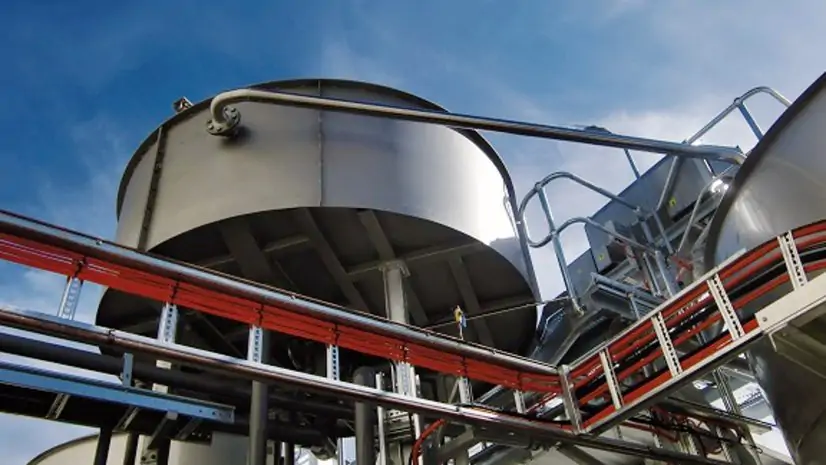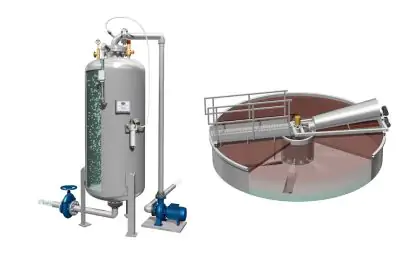Dissolved Air Flotation Units: Applications

High efficiency, simplicity and reliability: we are talking about water treatment systems always used for the separation of suspended solids and other particles. What are the applications of dissolved air flotation units? Let’s see some of them below.
1. Paper mills
Historically, paper mills represent one of the first applications of dissolved air flotation systems. Dissolved air flotation units are used in paper mills for two different applications. The main use is as a process machine: this system allows to recover most of the paper fibers that constitute the raw material and that would otherwise be lost with the cloth washing water.
Secondly, dissolved air flotation units are used for the purification treatment of wastewater, in particular for the removal of suspended solids and the COD linked to them. In both cases, the system is ideal for optimizing the solids recovery yield thanks to the effectiveness of its air dissolving system.
2. Confectionery industries
One of the main applications of the dissolved air flotation system is the pre-treatment of waste water in the confectionery industry. The different production lines are subjected to frequent washing both for hygiene reasons and when products with different characteristics are produced. The process water of the confectionery industry is characterized by high levels of suspended solids, COD and fats.
Dissolved air flotation systems, used as a pre-treatment upstream of a biological treatment, or before discharge into the sewer system, allow these parameters to be substantially reduced. This allows the size to be reduced and the operation of a possible biological plant downstream to be optimized. Alternatively, a lower polluting load allows companies to discharge their waste water into the sewer system within the values set by the most stringent regulations. The simplicity of management is such that it does not require specialized personnel to operate the system.
3. Cured meat factories
The water coming out of the sausage factories contains high levels of fats and suspended solids, deriving from the meat processing and stuffing process. The presence of these substances can create problems for the biological wastewater treatment plant. Fats inhibit the development of bacterial flora, and the high polluting loads require large-sized treatment plants with long residence times of the wastewater in the biological treatment tanks.
Flotation units intervene on both fronts. Used as a pre-treatment, it allows the removal of fats and suspended solids with extremely high efficiency, thanks to the innovative air dissolving system.
4. Primary and secondary clarification for biological plants
The dissolved air flotation system is widely used as a clarification phase in biological plants of all potentials. Thanks to its high efficiency in removing suspended solids, this solution is useful for the primary clarification of wastewater because it allows the use of extremely small spaces. The efficiency of solids removal is such as to drastically reduce the size of subsequent treatment phases.
For the same reasons, it is also used for secondary clarification, with an additional advantage. The sludge extracted from the flotation unit has a density approximately double that of the sludge extracted from a traditional sedimentation system. This allows for a reduction in the costs of sludge disposal or of creating any sludge treatment line. Furthermore, a denser sludge is recirculated, with obvious savings on the quantity of recirculation and consequently on the size of the oxidation tank.
5. Dairy industries
This is an application very similar to that of salami factories. In these companies, washing occurs very frequently and the waste water is rich in fats and highly biodegradable solid substances. The polluting load is very high and the treatment of this water requires the construction of large plants even when the flow rates involved are relatively low. The flotation unit, in this context, is widely used as a pre-treatment.
Its small size allows it to be installed even on existing plants or in any case where there are space problems. The dissolved air quickly brings solids and fats to the surface, without problems of bad odors and with extremely high removal efficiency. This allows the polluting load to be reduced and therefore the size of the entire plant. Flotation systems are often used even on existing plants that need to be upgraded.
Tell us your needs6. Oil & gas industries
Oil depots and refineries are large-scale facilities. Rainwater and runoff water that falls on yards and buildings must necessarily be treated before being discharged. In addition to this, there is also the displacement and washing water in general. A peculiar characteristic of these waters is the presence of considerable quantities of oil. Dissolved air flotation units are effective solutions for their removal.
Flotation certainly has the advantages of removal efficiency, small dimensions, and the possibility of inserting the machine into the context of an existing plant. If the company already has its own biological purification plant, the system allows for an increase in efficiency by removing upstream all substances that could inhibit the correct functioning of the biological process.
7. Textile industries
The waters coming out of these companies are rich in fibers that escape from the various washing processes to which the raw wool is subjected. The raw material is rich in solids, fats and organic substances, which are removed with the washing waters. In the waters there are also abundant quantities of surfactants deriving from the detergents used for washing.
Dissolved air flotation systems have proven to be effective systems for the treatment of these waters, upstream of any biological and/or chemical-physical processes. They allow the removal of approximately 80% of the fats and solids contained in the waters, and also carry out a partial reduction of the surfactants linked to the latter. The micro air bubbles that are generated in the saturator and that are released in the flotation tank are so fine that they do not cause the formation of foam despite the high levels of surfactants.
8. First rain waters
Runoff water from yards, car parks and warehouses must necessarily be treated before it can be conveyed to the drain. Such water is mainly rich in particulate matter, oils from machines and mechanical equipment and suspended solids.
The quantities of water involved are very high and absolutely inconsistent because they are linked to meteorological events, both in frequency and intensity. In these cases, the optimal solution is to provide storage with a capacity that can contain all the water to be treated, which will then be treated at a later time. For the removal of oils and suspended solids, flotation units are an excellent solution. The small size, ease of positioning and operation and the high reduction yield of solids and oils mean that the outgoing wastewater can be conveyed to the final drain, compatible with the regulations in force on the matter.
9. Upgrading of existing flotation units
All Mitadaf flotation units from MITA Water Technologies are equipped with a Mitasat air saturator, which is the heart of the flotation process. Mitasat allows you to create the air-water mixture needed for flotation. In addition to our flotation units, we supply Mitasat separately for the enhancement of existing flotation units, with the aim of maximizing their performance.
The high efficiency of dissolving air in water allows you to maximize the performance of equipment that is not produced by us. Mitasat also uses all the compressed air that is introduced into it, thus resulting in significant savings.
Ask for InformationResources
Needs of wastewater treatment
Discover the solution for all needsComparing different technologies
Find out all the different technologiesFind out more
All technical articlesOur Newsletter
Sign up for the MITA Water Technologies newsletter: stay up-to-date on systems for municipal and industrial wastewater treatment and filtration.
